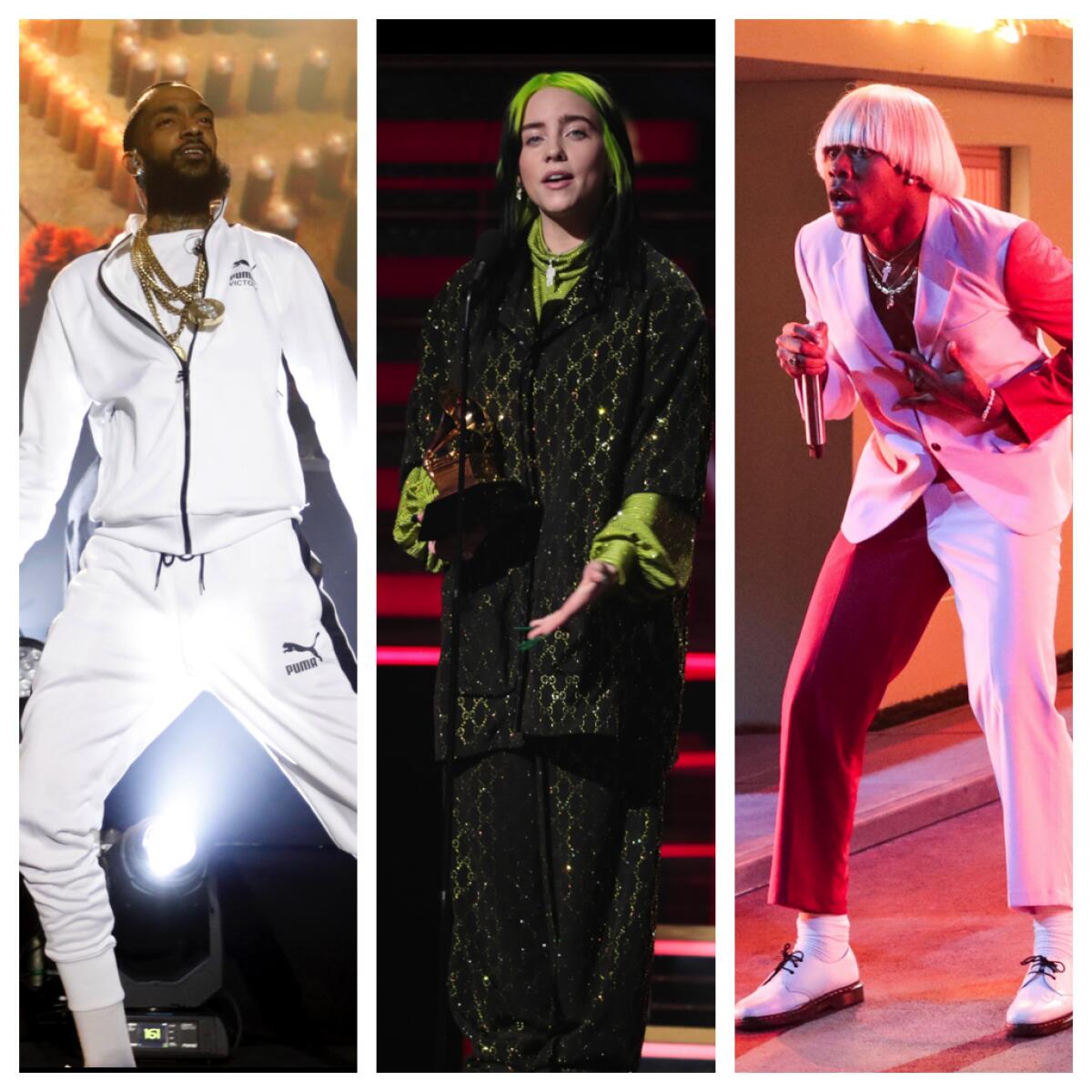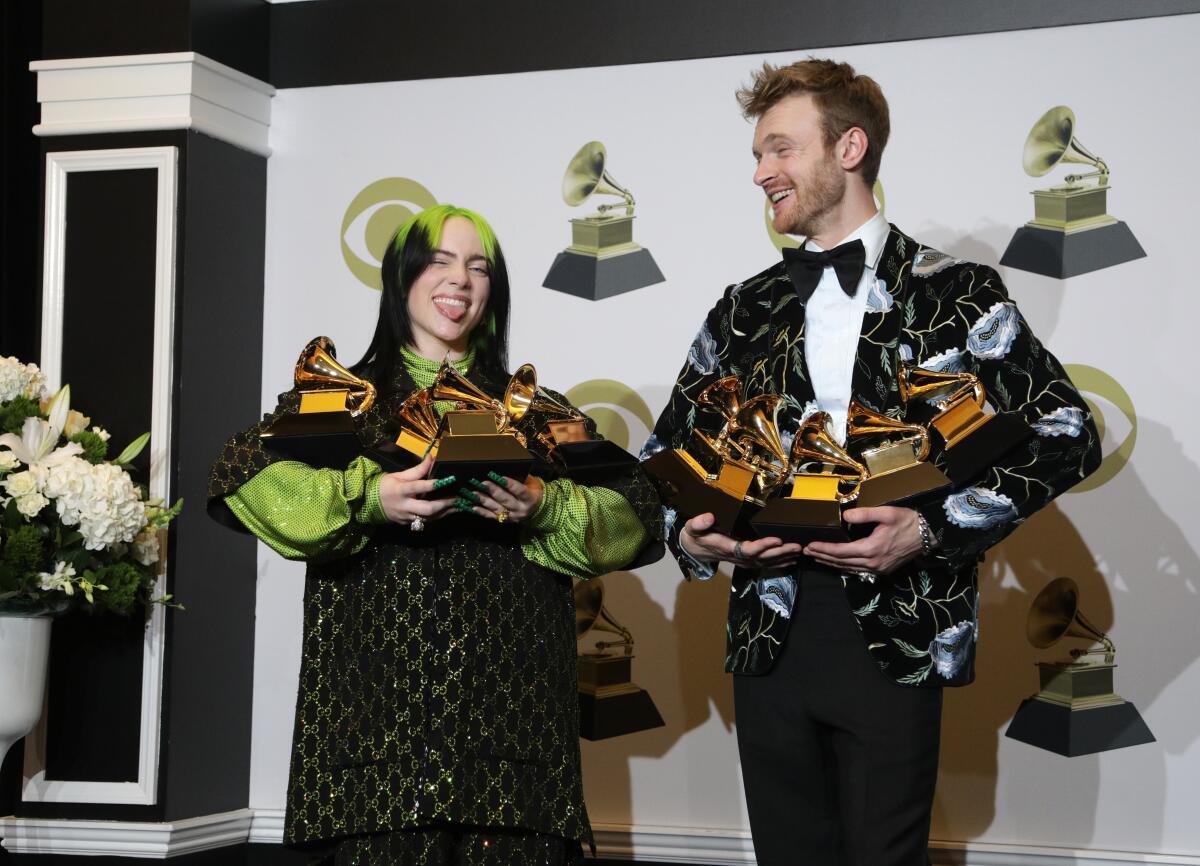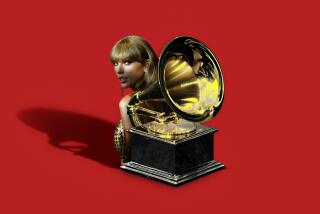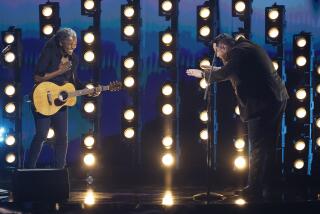When L.A. most needed it, 3 hometown Grammy winners did the city proud

- Share via
For those keeping score, Los Angeles had a big night at the 2020 Grammy Awards, even if Kobe Bryant’s death will forever mark the event in the minds of most residents.
Billie Eilish, Tyler, the Creator and the late Nipsey Hussle were all born and raised in Los Angeles, and their families were in Staples Center to prove it.
The artists took home a combined eight trophies, including Eilish’s record-setting sweep of the ceremony’s four biggest awards, Tyler’s win for rap album and Hussle’s two trophies for rap performance and rap-sung performance. Add in Oxnard’s Anderson .Paak, who won two R&B awards, and it’s clear the home team earned this year’s bragging rights.
As it turned out, the moment called for it. Outside Staples Center on Sunday, a growing mass of mourners had made a pilgrimage to the “House That Kobe Built.” Inside, the city’s musicians stepped up to command the stage and work through a few stages of grief. Tyler raged. Billie offered a melancholy, minor-key ballad. Nipsey peers including Compton’s YG and Roddy Ricch worked on acceptance, as evidenced by the performance’s coda, which offered a measure of comfort by presenting towering images of Hussle and Bryant side by side.
After the awards ceremony was over, though, their families didn’t return to their “Los Angeles” homes. This is a big place. Their kin headed toward enclaves within L.A. County’s tapestry of townships, and their routes to and from the Grammys say a lot about the geography of Los Angeles music and the ways in which experience begets a vision.
Each carried a perspective carved not by the Los Angeles of the popular imagination but inside homes in humble neighborhoods that feel more like small-town America than you might think.
“When you tell people that you’re from L.A., usually they can’t believe it,” Grammy-winning producer and songwriter Greg Kurstin told The Times last year, adding that he has compared notes with fellow natives Joey Waronker and Beck: “It’s a very unique place to grow up. You have all of the celebrities in one corner, and you have the culture that L.A. brings, and it’s all mixed together.”

Eilish’s crew is from Highland Park, and to get home from the Grammys they likely took the winding 110 north toward Pasadena before veering west toward the York commercial district. A dense area with an even mix of single-family homes and apartment buildings, over the past decade it’s been gentrified, even if Eilish’s parents, working actors who home-schooled their kids, moved into the neighborhood long before the hipsters arrived.
Eilish and her older brother, Finneas, grew up as the area was building a music scene. Like 1960s Laurel Canyon, the Sunset Strip’s 1980s hair-metal heyday and Compton’s seminal early-’90s gangsta rap era, Highland Park is dense with musical creativity.
In various interviews Eilish has recalled wandering up and down Highland Park’s York Boulevard, and those who know the area can imagine her and Finneas roaming a neighborhood where places like Café de Leche, Future Music, the Hermosillo, Galco’s Old World Grocery, Permanent Records, La Estrella taco truck and Rappcats give the place the feel of a (particularly awesome) working-class town. Her first gig was at the Hi Hat in that same strip of businesses; until a few years ago, it was a pool hall.
During the ceremony, Eilish thanked Tyler, the Creator for the inspiration. Eilish was 8 when Tyler’s Odd Future collective stormed the internet; Tyler had just been fired from his job at a Starbucks about 20 miles southwest in Hawthorne for stealing cheese danishes.

The artist was born Tyler Okonma to a mixed-race mother and a Nigerian father (whom he never met), and grew up in Hawthorne and Ladera Heights. After his mom stood teary-eyed and beaming beside her son as he accepted the rap album trophy on Sunday, she likely took the westbound 10 toward southbound La Cienega or La Brea.
Dubbed by his fellow Odd Future member Frank Ocean in “Sweet Life” as “the black Beverly Hills,” Ladera Heights boasts a wonderful vantage point: a perch in the Baldwin Hills, 10 miles due south of the iconic Hollywood Hills neighborhood above the Sunset Strip. You can watch the planes land and, if you live in the right spot, see both sunrise and sunset.
Tyler and his crew came up on a diet of skateboards, video games, N.E.R.D., Missy Elliott and punk, a posse of curb-jumping daredevils who took advantage of wide suburban avenues and a wide-open platform called YouTube to express themselves. Without much guidance, they went for it. “The first time [Tyler] recorded, he closed the studio door on us and made us wait outside,” the R&B star Syd, who got her start as Odd Future’s DJ, said in 2011.

But on Sunday, as Tyler tore through his new song, “New Magic Wand,” all those influences and that energy came shockingly to life and revealed the artist to be a new brand of L.A. Renaissance man: music, fashion, film and image. Best, in the press room backstage, he had no problem directly addressing long-simmering, and recently exploding, issues of fairness in the awards.
Calling himself “half and half” on the Grammys, he said: “On one hand, I’m just grateful that what I made can be acknowledged in a world like this. But also, it sucks that whenever we — and I mean guys that look like me — do anything that’s genre-bending or anything, they also put it in a rap or urban category. And I don’t like the ‘urban’ word. It’s just a politically correct way to say the n-word.”

For Nipsey Hussle’s family, Sunday was no doubt a bittersweet experience, and after the ceremony they retreated, at least in spirit, to Hussle’s spiritual home at the corner of Crenshaw and Slauson. Like Tyler’s Ladera Heights, it’s just north of the LAX inbound flight path, but about two miles further inland. As most know by now, Hussle lived and died in the same neighborhood.
The oldest of three kids, Hussle came from a family whose patriarch was an emigrant of the East African country Eritrea. At the beginning of the rapper’s career, he hustled his music the same way Col. Tom Parker and Leonard Chess did: from the trunk of his car. Though he came up in the download era, Hussle shilled his mix CDs to would-be listeners who still had players in their rides — basically pulling a Johnny Appleseed by spreading the fruits of his labor person to person.
“Nip did it not just for the awards but for the people,” his girlfriend Lauren London said in accepting one of his two Grammys. Specifically, Hussle told The Times in 2018 that his music and his energy were driven by the plight of those in his ZIP Code.
“We dealt with death, with murder,” he told The Times in 2018 of growing up in Crenshaw. “It was like living in a war zone, where people die on these blocks and everybody is a little bit immune to it.” He described a neighborhood filled with residents who “have been at war for such a long time. I think L.A. suffers from that because it’s not normal yet we embrace it like it is after a while.”
Thankfully, neither Tyler nor Eilish experienced as much gangland violence as Hussle. But their achievements at Sunday’s Grammys serve as a reminder of the varied paths that led to them converging at the corner of Figueroa and 11th, and the ways in which musicians and fans tap music’s essential powers when the times demand it.
More to Read
The biggest entertainment stories
Get our big stories about Hollywood, film, television, music, arts, culture and more right in your inbox as soon as they publish.
You may occasionally receive promotional content from the Los Angeles Times.











